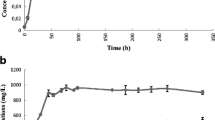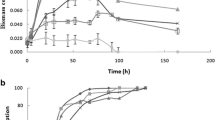Abstract
“Clostridium ragsdalei” is an acetogen that ferments synthesis gas (syngas, predominantly H2:CO2:CO) to ethanol, acetate, and cell mass. Previous research showed that C. ragsdalei could also convert propionic acid to 1-propanol and butyric acid to 1-butanol at conversion efficiencies of 72.3 and 21.0 percent, respectively. Our research showed that C. ragsdalei can also reduce pentanoic and hexanoic acid to the corresponding primary alcohols. This reduction occurred independently of growth in an optimized medium with headspace gas exchange (vented and gassed with CO) every 48 h. Under these conditions, conversion efficiencies increased to 97 and 100 % for propionic and butyric acid, respectively. The conversion efficiencies for pentanoic and hexanoic acid to 1-pentanol and 1-hexanol, respectively, were 82 and 62 %. C. ragsdalei also reduced acetone to 2-propanol at a conversion efficiency of 100 %. Further, we showed that C. ragsdalei uses an aldehyde oxidoreductase-like enzyme to reduce n-fatty acids to the aldehyde intermediates in a reaction that requires ferredoxin and exogenous CO.





Similar content being viewed by others
References
Allen TD, Caldwell ME, Lawson PA, Huhnke RL, Tanner RS (2010) Alkalibaculum bacchi gen. nov., sp. nov., a CO-oxidizing, ethanol-producing acetogen isolated from livestock-impacted soil. Int J Syst Evol Microbiol 60:2483–2489
Balch WE, Wolfe RS (1976) New approach to the cultivation of methanogenic bacteria: 2-mercaptoethanesulfonic acid (HSCoM)-dependent growth of Methanobacterium ruminantium in a pressurized atmosphere. Appl Environ Microbiol 32:781–791
Bornscheuer UT, Huisman GW, Kazlauskas RJ, Lutz S, Moore JC, Robins K (2012) Engineering the third wave of biocatalysis. Nature 485:185–194
Bradford MM (1976) A rapid and sensitive method for the quantitation of microgram quantities of protein utilizing the principle of protein-dye binding. Anal Biochem 72:248–254
Bruant G, Lévesque M-J, Peter C, Guiot SR, Masson L (2010) Genomic analysis of carbon monoxide utilization and butanol production by Clostridium carboxidivorans strain P7T. PLoS One 5:313033
Chen J-S, Blanchard DK (1979) A simple hydrogenase-linked assay for ferredoxin and flavodoxin. Anal Biochem 93:216–222
Coyle W (2007) The future of biofuels. Economic Res Service/USDA, Washington
Drake HL, Kusel K, Matthies C (2006) Acetogenic prokaryotes. In: Dworkin M, Falkow S, Rosenberg E, Shleifer K-H, Stackebrandt E (eds) The Prokaryotes, 3rd edn. Springer, Berlin, pp 354–420
EIA (2012) Annual Energy Outlook 2012. Energy Information Administration. Report No: DOE/EIA-0383(2012)
Fraisse L, Simon H (1988) Observations on the reduction of non-activated carboxylates by Clostridium formicoaceticum with carbon monoxide or formate and the influence of various viologens. Arch Microbiol 150:381–386
Granberg RA, Rasmuson ÅC (1999) Solubility of paracetamol in pure solvents. J Chem Eng Data 44:1391–1395
Henstra AM, Sipma J, Rinzema A, Stams AJM (2007) Microbiology of synthesis gas fermentation for biofuel production. Curr Op Biotech 18:200–206
Hüsemann MHW, Papoutsakis ET (1990) Effects of propionate and acetate additions on solvent production in batch cultures of Clostridium acetobutylicum. Appl Environ Microbiol 56:1497–1500
IEA (2009) Key world energy statistics. Internation Energy Agency, Paris
Kenealy WR, Waselefsky DM (1985) Studies on the substrate range of Clostridium kluyveri; the use of propanol and succinate. Arch Microbiol 141:187–194
Kirschner M (2006) n-Butanol. Chem Mark Rep 269:42
Köpke M, Held C, Hujer S, Liesegang H, Wiezer A, Wollherr A, Ehrenreich A, Liebl W, Gottschalk G, Dürre P (2010) Clostridium ljungdahlii represents a microbial production platform based on syngas. PNAS 107:13087–13092
Liou JS, Balkwill DL, Drake GR, Tanner RS (2005) Clostridium carboxidivorans sp. nov., a solvent-producing clostridium isolated from an agricultural settling lagoon, and reclassification of the acetogen Clostridium scatologenes strain SL1 as Clostridium drakei sp. nov. Int J Syst Evol Microbiol 55:2085–2091
Liu K, Atiyeh HK, Stevenson BS, Tanner RS, Wilkins MR, Huhnke RL (2014) Mixed culture syngas fermentation and conversion of carboxylic acids into alcohols. Biores Tech 152:337–346
Marchler-Bauer A et al (2013) CDD: conserved domains and protein three-dimensional structure. Nucleic Acids Res 41:D384
Markowitz VM et al (2014) IMG 4 version of the integrated microbial genomes comparative analysis system. Nucl Acids Res 42:D560–D567. http://img.jgi.doe.gov/er
Perez JM, Richter H, Loftus SE, Angenent LT (2012) Biocatalytic reduction of short-chain carboxylic acids into their corresponding alcohols with syngas fermentation. Biotechnol Bioeng 110:1066–1077
Pierce E, Xie G, Barabote RD, Saunders E, Han CS, Detter JC, Richardson P, Brettin TS, Das A, Ljungdahl LG, Ragsdale SW (2008) The complete genome sequence of Moorella thermoacetica (f. Clostridium thermoaceticum). Env Microbiol 10:2550–2573
Ramachandriya KD, Wilkins MR, Delorme MJM, Zhu X, Kundiyana DK, Atiyeh HK, Huhnke RL (2011) Reduction of acetone to isopropanol using producer gas fermenting microbes. Biotechnol Bioeng 108:2330–2338
Ridjan I, Mathiesen BV, Connolly D (2014) Synthetic fuel production costs by means of solid oxide electrolysis cells. Energy 76:104–113
Saxena JS, Tanner RS (2010) Effect of trace metals on ethanol production from synthesis gas by the ethanologenic acetogens, Clostridium ragsdalei. J Ind Microbiol Biotechnol 38:513–521
Sheih J, Whitman WB (1988) Autotrophic acetyl coenzyme A biosynthesis in Methanococcus maripaludis. J Bacteriol 170:3072–3079
Simon H, White H, Lebertz H, Thanos I (1987) Reduction of 2-enoates and alkanoates with carbon monoxide or formate, viologens, and Clostridium thermoaceticum to saturated acids and unsaturated alcohols. Angew Chem Int Ed Engl 26:785–787
Simon H, Lebertz H (1989) Microbial reduction of monocarboxylic and dicarboxylic acids in the presence of carbon monoxide and/or formates plus mediators. United States Patent No. 4, 851, 344
Steinbusch KJJ, Hamelers HVM, Buisman CJN (2008) Alcohol production through volatile fatty acid reduction with hydrogen as electron donor by mixed cultures. Water Res 42:4059–4066
Steinbusch KJJ, Arvaniti E, Hamelers HVM, Buisman CJN (2009) Selective inhibition of methanogenesis to enhance ethanol and n-butyrate production through acetate reduction in mixed culture fermentation. Biores Technol 100:3261–3267
Strobl G, Feicht R, White H, Lottspeich F, Simon H (1992) The tungsten-containing aldehyde oxidreductase from Clostridium thermoaceticum and its complex with a viologen-accepting NADPH oxidoreductase. Biol Chem Hoppe-Seyler 373:123–132
Tanner RS (2007) Cultivation of bacteria and fungi. In: Hurst CJ, Crawford RL, Mills AL, Garland JL, Stetzenbach LD, Lipson DA (eds) Manual of environmental microbiology, 3rd edn. ASM Press, Washington, pp 69–78
Thauer RK, Jungermann K, Decker K (1977) Energy conservation in chemotrophic anaerobic bacteria. Bacteriol Rev 41:100–180
Tilman D, Socolow R, Foley JA, Hill J, Larson E, Lynd L, Pacala S, Reilly J, Searchinger T, Somerville C, Williams C (2009) Beneficial biofuels: the food, energy, and environment trilemma. Science 325:270–271
Wang S, Zhang Y, Dong H, Mao S, Zhu Y, Wang R, Juan G, Li Y (2011) Formic acid triggers the “acid crash” of acetone-butanol-ethanol fermentation by Clostridium acetobutylicum. Appl Environ Microbiol 77:1674–1680
White H, Huber C, Feicht R, Simon H (1993) On a reversible molybdenum-containing aldehyde oxidoreductase from Clostridium formicoaceticum. Arch Microbiol 159:244–249
Acknowledgments
This research was supported in part by the USDA-CSREES special research grant award. The authors thank Jarrod Warnock and Dr. Ravindranath Garimella for collecting NMR spectra. The authors also thank Dr. Elizabeth Karr for in vitro protein work and Dr. Johannes Kung for collecting acyl-CoA spectra (Supplmental Data).
Author information
Authors and Affiliations
Corresponding author
Electronic supplementary material
Below is the link to the electronic supplementary material.
Rights and permissions
About this article
Cite this article
Isom, C.E., Nanny, M.A. & Tanner, R.S. Improved conversion efficiencies for n-fatty acid reduction to primary alcohols by the solventogenic acetogen “Clostridium ragsdalei”. J Ind Microbiol Biotechnol 42, 29–38 (2015). https://doi.org/10.1007/s10295-014-1543-z
Received:
Accepted:
Published:
Issue Date:
DOI: https://doi.org/10.1007/s10295-014-1543-z




